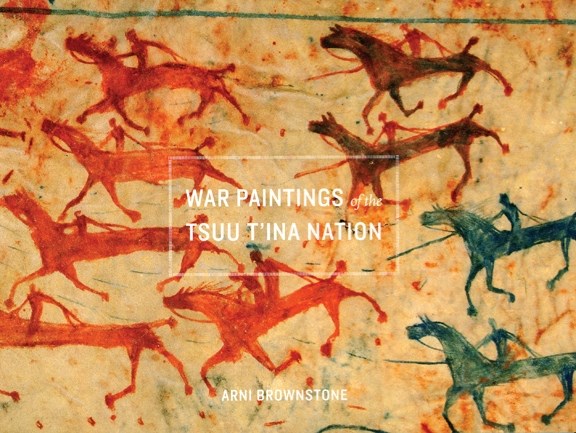During the winter of 1860, as Tsuu T’ina hunters and their families killed and butchered a small herd of bison they had trapped in a log pound near the Battle River and Dried Meat Lake, a group of Cree warriors surrounded and attacked them.
Some of the Tsuu T’ina, including their head chief, Bull Head, ran for their nearby camp where they fought off the Cree. During the fight, Bull Head rushed into his tipi for his rifle, killing a Cree attacker with a well-aimed shot through the tipi entrance.
Years later, Tsuu T’ina artists sat down and recorded the exploits of Tsuu T’ina warriors, including those of Bull Head, on tipi covers and liners, robes and shirts.
Today these paintings, known as war exploit paintings, offer a window into the past of the people of the Tsuu T’ina First Nation (also known as Sarcee or Sarsi) and of the history of the Great Plains, specifically warfare and how it was recorded and shared.
“(These paintings) enrich our understanding of the Tsuu T’inas (and provide) insight into an important form of visual communication once practiced by more than 30 Indian tribes across the Great Plains of North America,” writes Arni Brownstone in his recent book War Paintings of the Tsuu T’ina Nation.
“Their primary purpose was to keep a man’s proficiency as a warrior in public view, and accordingly they were executed on visible surfaces: robes, shirts, tipi covers and tipi liners.”
Brownstone, assistant curator of Plains Indian Culture at the Royal Ontario Museum in Toronto, discusses in his book five paintings produced between 1875 and 1920, interpreting the stories and the history that the pictographic imagery tells on these Tsuu T’ina robes and tipi liners. The paintings are today in held in collections at the Royal Ontario Museum, American Museum of Natural History, Tsuu T’ina Museum and Cultural Centre, Burke Museum of Natural History and the American Museum of Natural History.
The five paintings- – three tipi liners and a robe – are episodic, sharing a number of exploits at once rather than just one story or exploit. The paintings also tend to cross over from one to another, sharing some of the same stories and events, such as Bull Head killing the Cree warrior. This story can be seen in each of these five key paintings that form the backbone of Brownstone’s book.
Along with sharing many of the same stories, these paintings also share the same artists, and two men in particular created the majority of the pictographic images. Brownstone identified that a man known as Two Guns, who was described by the Tsuu T’ina as the tribe’s painter and recorder, made 68 per cent of the images on the five paintings.
“(Two Guns’) work vividly evoked the high drama, danger, and exhilaration of warfare while accurately recording detail,” writes Brownstone. “It was his broad repertoire of expressive figure poses and tendency toward full pictorial description, as distinct from the ‘frozen’ figures and shorthand narrative style of earlier pictographic traditions that distinguished Two Guns from his contemporaries.”
Another Tsuu T’ina artist, Fire Long Ago, painted five per cent of the paintings. Brownstone was unable to identify the men who painted the remaining 22 per cent of the five paintings.
Brownstone shares both the full robe or tipi liner, providing the visual context, and the individual exploits set apart from each other with its interpretation and how it fits with the greater context of Tsuu T’ina and Plains history. This approach helps readers see beyond the artwork and into the lives of the people represented in the painted figures.
“While they greatly enrich our understanding of the Tsuu T’ina, these paintings provide insight on an important form of visual communication once practiced by the more than 30 Indian tribes across the Great Palins of North America. This study illustrates how the dynamics of the larger plains interethnic configuration played an important role in shaping the art of the Tsuu T’inas and, by extension, all the tribes in the region.”
But the pictographic imagery is only one part of the story; the rest is rooted in the oral tradition.
“Plains Indian pictography was also inextricably bound to oral tradition, since the spoken word was the primary means of disseminating a man’s war stories,” writes Brownstone. “The direct conversion of pictographic war records into spoken words can only be partial, since prior knowledge of the depicted events is required for their full enunciation.”
Even though the focus of the book is on the Tsuu T’ina war exploit paintings, Brownstone provides a significant amount of background by addressing the history of the Plains peoples, and in general war exploit painting, and intertribal warfare on the Great Plains. These background chapters are short yet extremely helpful in understanding a complex history.
War Paintings of the Tsuu T’ina Nation is one of those books that anyone interested in the history of the Indigenous people of the Great Plains hopes comes along, perhaps without even knowing it. These paintings and their imagery are not an unknown or obscure art form, but at the same time it requires specialized and often intimate knowledge to understand.
Brownstone has done an admirable job providing just enough information and research to allow readers to understand the context of war exploit paintings, the history of the Tsuu T’ina on the Great Plains and the interpretation of this complex, beautiful and dynamic form of storytelling.
War Paintings of the Tsuu T’ina Nation by Arni Brownstone is published by The University of Alberta Press. It is available for $35.




